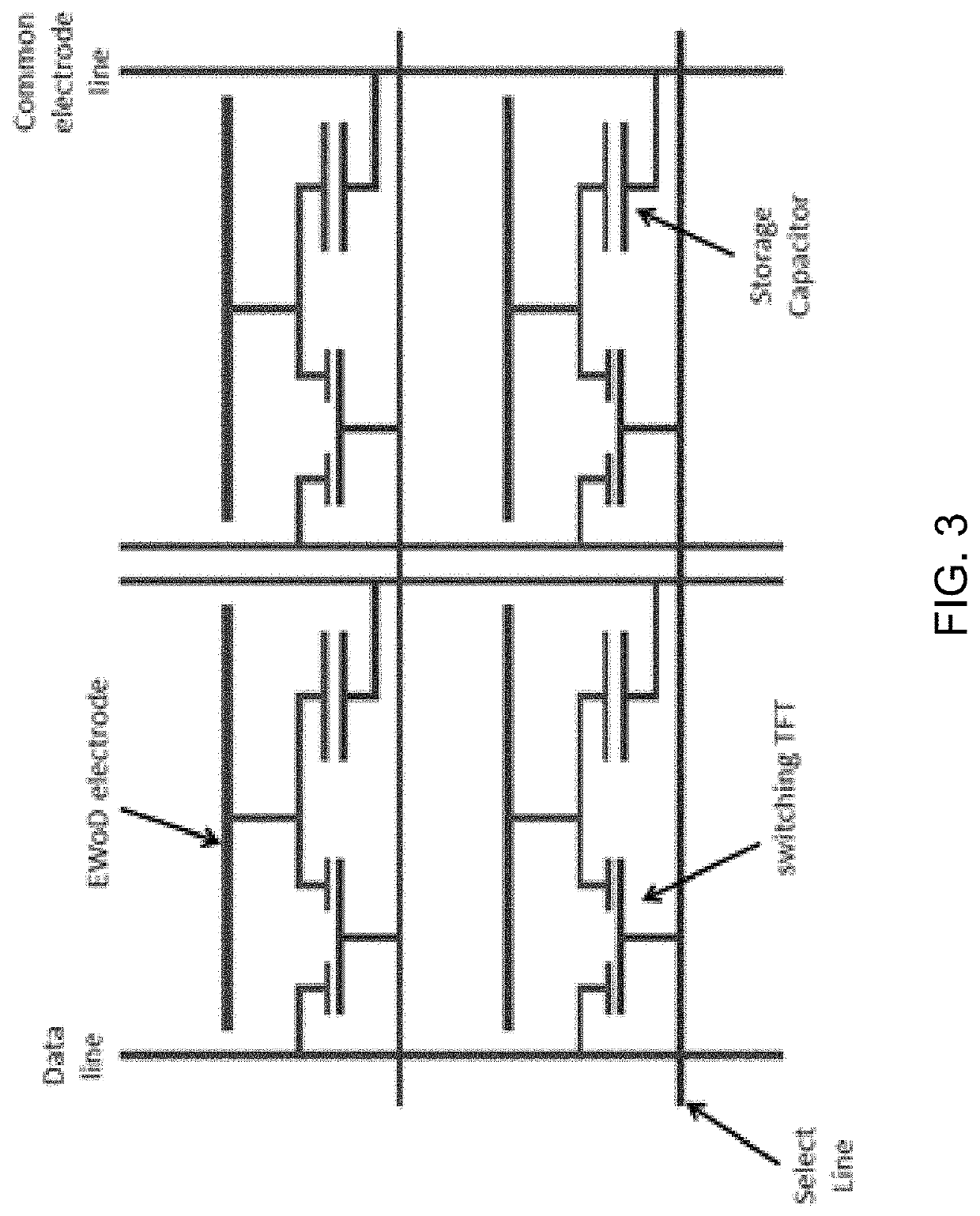Variable electrode size area arrays on thin-film transistor based digital microfluidic devices for fine droplet manipulation
a technology of thin-film transistors and microfluidic devices, applied in fluid controllers, laboratory glasswares, laboratory apparatus, etc., can solve the problems of requiring faster (and more expensive) drivers, unable to perform massive parallel assays, reactions, etc., and limited number of electrodes, etc., to achieve the effect of simplifying the fabrication of the device and simplifying the data handling associated
- Summary
- Abstract
- Description
- Claims
- Application Information
AI Technical Summary
Benefits of technology
Problems solved by technology
Method used
Image
Examples
example 1
[0035]The diagram of FIG. 1 illustrates the structure of an exemplary variable size electrode array. The array is partitioned into three areas 10, 12, and 14, where the subarray of each area is defined by its respective drive line density a, b, or c. While the areas of FIG. 1 have the same row and column line density, this is not a requirement. For instance, area 10 may be characterized by row line density a, but also by a column line density a*, which may be greater or lesser than a, depending on the requirements of the application at hand. In one exemplary implementation, lower density areas branch away from a high-density area. In addition, if desired, the gate and source lines may be terminated to adjust for a desired density as one ventures deeper into the array to avoid extra capacitance in the lower density areas arising from the high-density lines. The advantage to this design feature is the ability to carry out high-resolution operations on the array at reduced gate and / or ...
example 2
[0037]Illustrated in FIG. 6 is the structure of another exemplary variable size array. Area 50 is of line density (row and column) a, and area 32 is of line density b. Line density a is greater than b. As such, if D1 is defined as the electrode density of area 50, as expressed for instance in terms of number of electrodes per 100 mm2, and D2 is defined as the electrode density of area 52, then the ratio D1:D2 exceeds the value of 1. In representative embodiments, the ratio D1:D2 is equal to about 2′, n being a natural number, so as to maintain a square electrode format. For example, the ratio D1:D2 may be equal to about 2, 4, 8, or 16 to suit the application at hand. The size of individual electrodes in AM-EWoD devices usually falls in a range from about 50 μm to about 600 μm. Hence, if the electrodes of area 52 are 600 μm in size, those of area 50 may be 300, 150, or 75 μm depending on whether the desired ratio D1:D2 is 2, 4, or 8.
[0038]Embodiments where the D1:D2 ratio is equal to...
example 3
[0040]The schematic drawing of FIG. 7 illustrates an example AM-EWoD device 60. Reservoirs R1 contain a first type of fluid, reservoirs R2 a second type of fluid, and reservoir R3 a third type of fluid. The TFT array of the device includes high electrode density areas 62 in the proximity of the reservoir inlets, so that sample droplets can be taken from a reservoir and deposited on the surface of a high electrode density area. The high electrode density of the subarrays of areas 62 enables carrying out assay steps such as diluting, mixing, and sizing (splitting) of sample droplets with high accuracy. In one example embodiment, a sample droplet to be assayed for the presence and optionally the concentration of an analyte to is diluted by combination with one or more droplets of a solvent, and the dilution step may be repeated until a desired analyte concentration range is attained. Then, a droplet of the diluted sample is mixed with droplet(s) of one or more reactants that form a det...
PUM
| Property | Measurement | Unit |
|---|---|---|
| size | aaaaa | aaaaa |
| size | aaaaa | aaaaa |
| area | aaaaa | aaaaa |
Abstract
Description
Claims
Application Information
 Login to View More
Login to View More - R&D
- Intellectual Property
- Life Sciences
- Materials
- Tech Scout
- Unparalleled Data Quality
- Higher Quality Content
- 60% Fewer Hallucinations
Browse by: Latest US Patents, China's latest patents, Technical Efficacy Thesaurus, Application Domain, Technology Topic, Popular Technical Reports.
© 2025 PatSnap. All rights reserved.Legal|Privacy policy|Modern Slavery Act Transparency Statement|Sitemap|About US| Contact US: help@patsnap.com



